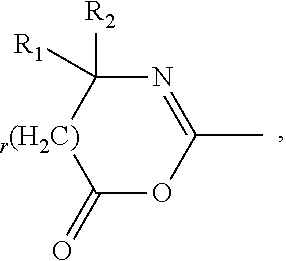Amphiphilic polysiloxane prepolymers and uses thereof
a polysiloxane and amphiphilic technology, applied in the field of amphiphilic polysiloxane prepolymers, can solve the problems of mold size fluctuations, molds that cannot be uniformly shrinked, and molds that cannot be uniformly sized,
- Summary
- Abstract
- Description
- Claims
- Application Information
AI Technical Summary
Benefits of technology
Problems solved by technology
Method used
Image
Examples
example 1
Oxygen Permeability Measurements
[0140]The apparent oxygen permeability of a lens and oxygen transmissibility of a lens material is determined according to a technique similar to the one described in U.S. Pat. No. 5,760,100 and in an article by Winterton et al., (The Cornea: Transactions of the World Congress on the Cornea 111, H. D. Cavanagh Ed., Raven Press: New York 1988, pp 273-280), both of which are herein incorporated by reference in their entireties. Oxygen fluxes (J) are measured at 34° C. in a wet cell (i.e., gas streams are maintained at about 100% relative humidity) using a Dk1000 instrument (available from Applied Design and Development Co., Norcross, Ga.), or similar analytical instrument. An air stream, having a known percentage of oxygen (e.g., 21%), is passed across one side of the lens at a rate of about 10 to 20 cm3 / min., while a nitrogen stream is passed on the opposite side of the lens at a rate of about 10 to 20 cm3 / min. A sample is equilibrated in a test media ...
example 2
[0156]Various percent ethylenically-functionalized polysiloxanes are prepared as follows. KF-6001A (α,ω-bis(2-hydroxyethoxypropyl)-polydimethylsiloxane, Mn=2000, from Shin-Etsu) and KF-6002A (α,ω-bis(2-hydroxyethoxypropyl)-polydimethylsiloxane, Mn=3400, from Shin-Etsu) are separately dried at about 60° C. for 12 hours (or overnight) under high vacuum in a single neck flask. The OH molar equivalent weights of KF-6001A and KF-6002A are determined by titration of hydroxyl groups and are used to calculate the milimolar equivalent to be used in the synthesis.
A-1. Synthesis of Partially Ethylenically-Functionalized Polysiloxanes
[0157]A one-liter reaction vessel is evacuated overnight to remove moisture, and the vacuum broken with dry nitrogen. 75.00 g (75 meq) of dried KF6001A is charged to the reactor, and then 16.68 g (150 meq) of freshly distilled isophorone diisocyanate (IPDI) is added into the reactor. The reactor is purged with nitrogen and heated to 45° C. with stirring and then 0....
example 3
[0160]This example illustrates the effects of percentage of ethylenically-functionalization of polydisiloxane, which is used to prepare a prepolymer that in turn is used to prepare lens formulation, upon the viscosities of the lens formulations.
B-1. Synthesis of Amphiphilic Branched Copolymer
[0161]A 1-L jacketed reactor is equipped with 500-mL addition funnel, overhead stirring, reflux condenser with nitrogen / vacuum inlet adapter, thermometer, and sampling adapter. 48.55 g of partially ethylenically-functionalized polysiloxane (PDMS) prepared in Example 2, A-1.1 is charged to the reaction vessel. The PDMS A-1.1 is degassed under vacuum less than 1 mbar at room temperature for 30 minutes. After the degassed is accomplished, the reactor is filled with nitrogen gas waiting for further process. The monomer solution composed of 26.06 g of N,N-dimethylacrylamide (DMA), 23.14 g of (tris(trimethylsilyl))siloxypropyl)-acrylamide (TRIS-Am), and 350 g of ethyl acetate is charged to the 500-mL ...
PUM
| Property | Measurement | Unit |
|---|---|---|
| Fraction | aaaaa | aaaaa |
| Fraction | aaaaa | aaaaa |
| Fraction | aaaaa | aaaaa |
Abstract
Description
Claims
Application Information
 Login to View More
Login to View More - R&D
- Intellectual Property
- Life Sciences
- Materials
- Tech Scout
- Unparalleled Data Quality
- Higher Quality Content
- 60% Fewer Hallucinations
Browse by: Latest US Patents, China's latest patents, Technical Efficacy Thesaurus, Application Domain, Technology Topic, Popular Technical Reports.
© 2025 PatSnap. All rights reserved.Legal|Privacy policy|Modern Slavery Act Transparency Statement|Sitemap|About US| Contact US: help@patsnap.com



